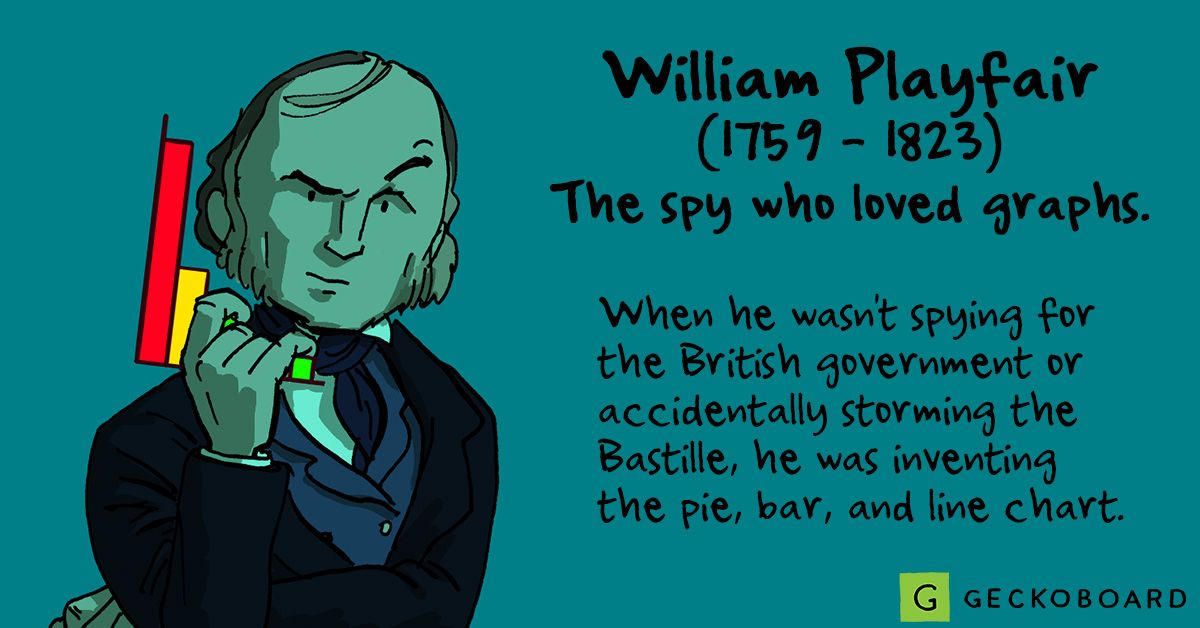Inventor of statistical graphs: Who is William Playfair?
William Playfair, born 1759, Scottish engineer, inventor, statistician, merchant, painter, silversmith, banker, bookseller, editor and speculator. Playfair is the name we have to thank for the graphics we use. Inventor of statistical graphs.

Image source: https://www.geckoboard.com/blog/stars-of-stats/
Statistical graphs also have an inventor, though not known to many: William Playfair. He was born on September 22, 1759, the son of a clergyman, in Scotland, one of the great engineering eras. He took so many jobs, tried so many things that when it comes to who William Playfair is, many titles come up.
William Playfair lived from 22 September 1759 to 11 February 1823. He was an engineer and political economist remembered primarily for his innovations in the presentation of quantitative information by means of graphs and charts. He invented the time series graph or line chart, the bar chart, and the pie chart.
His father died when William was only 13 years old. After the death of his father, he apprenticed to Andrew Meikle, one of the important names of the agricultural revolution, who was the inventor of the threshing machine. In 1777, he became James Watt's personal assistant at the engine factory Boultaon and Watt in Birmingham.
He left the company in 1782 after working for James Watt for 5 years. He established a silver working and sales shop in London. The company failed because things had been difficult for Playfair.
Playfair, whose business did not go well, later turned to painting. He learned from the drawing tables of Meikle and Watt and fell in love with painting. On the one hand, he works as a painter; At the same time, he was writing economics, which is another passion. He was very enthusiastic about writing about economics, but had a hard time explaining his ideas visually. That's why he painstakingly diagrammed his arguments. With these works, he laid the foundations of statistical graphics.
The “Commercial and Political Atlas” published in 1786 was the place where the bar graph was used for the first time and it was used by Playfair. He drew 43 time series charts and one bar chart in the Business and Political Atlas. Playfair had started a revolution but was little known in England.
Feeling underappreciated, he moved to Paris in 1787. He had seen his work read even by the king. Unfortunately, this reputation of Playfair did not last long. There was a revolution and political events in France at that time. Playfair also joined the hastily formed St Antonie Quarter militia.
After the French revolution, he went to Germany after a few job trials. He decided to continue engineering in Germany and produced a model of the device by copying the then newly invented telegraph. Later, he sent this model, together with a new alphabet he prepared for the telegraph, to the Duke of York. But the Duke of York was not impressed.
He returned to London in 1793. Here he founded the “Security Bank”. He was using banking techniques he had seen in Paris, but this attempt was also unsuccessful. As a result of a discussion with the Bank of England, this job was finished.
He was disappointed by the events in France (the revolution and the conflict with Britain). Playfair provided information to the British government about the events in France. He proposed several operations against the French.
He Wanted To Crash The French Economy
While spying, he presented a plan to Henry Dundas (England's Home Secretary). This plan is referred to as fraudulent. He said they could defeat the French with money, not guns and men. In France, the "assignat", a monetary instrument, was used during the French Revolution. He planned to spread the hundreds of millions of assignats to the country by imitating, that is, by forging them.
In this way he hoped to paralyze the French economy and prevent war. In 1795, Playfair's plan worked and the French assignat became worthless. Chaos ensued in the country and the French government suffered.
Unable to receive praise for his work, Playfair turned to bookstore. By the end of the 1790s he had been forced into debt. That's why he got into Fleet Prison for three years. It came out in 1802.
Later, he tried to return to work as a magazine editor in France. But he was tried for defamation and fled to England to avoid jail. While in England, he returned to publishing and dealing with graph papers and invented the pie chart.
The bar chart was first used by William Playfair in his 1786 Commercial and Political Atlas. Playfair's invention of the bar graph is said to have been inspired by Joseph Priestley's first timeline in 1765, where he used individual bars to visualize (in duration) a person's life.
Playfair first charted one year's trade data for Scotland. This first bar chart shows Scotland's imports and exports to 17 countries in 1781.
Playfair thought that graphics, or visualization, communicated better than data tables. That's why he invented the area, pie, line, and bar charts. Playfair's time series plans are cited as models of clarity even today. At the same time, this work is considered to be the first major work involving statistical graphics.
The pie chart was first used in the Statistical Breviary, published in 1801. So it's the first pie chart to be adopted.
